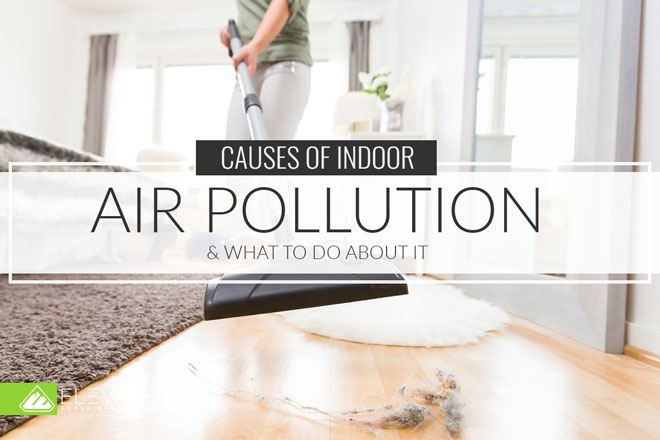You like to think that your house is your safe haven, right? I do. Unfortunately, the reality is that our homes can sometimes be the most dangerous place that we go in the entire day. It may sound like an exaggeration, but it’s really not. The health effects of poor indoor air quality – what we call indoor air pollution – are far reaching.
The smog around your city is not the only place where health-hazardous chemicals and toxins pile up. Your very own living room, kitchen, and even the baby’s nursery could be harboring pollutants that are annoying at best and life-threatening at worst.
Together, we’re going to do something about it.
TRUTH BOMB:
You’re
Already killing it!
If You Were More Consistent With Your Wellness Routine, You’d Be Unstoppable.
To protect yourself and your loved ones you have to know what to look for and what to do about it. First we have to dive into the nitty-gritty. We need to take a good, hard look at the causes of air pollution and how they are directly, and often severely, harming our health.
But then we have to figure out how to rise above it all. So we’re going to walk you through indoor air quality testing options – including home air quality test kits – that will give you a clear picture of what’s going on in your home.
Finally, we will wrap up with lots of tips that will help you do something about the causes of air pollution. We will learn how to reduce air pollutants and how to prevent air pollution altogether.
Health Effects of Indoor Air Pollution
There’s a large range of health problems that can pop up from indoor air pollution. Most of these are a result of inflammation – the root cause behind the detrimental health issues associated with indoor air pollution. Here are some of the symptoms you can expect if air pollutants are in your home:
- Irritated eyes, nose, and throat
- Coughing or sneezing
- Headaches
- Nausea
- Fatigue
- Weakness
- Dizziness
- Digestive problems
- Shortness of breath
- Asthma
- Flu-like symptoms
- Fever
- Angina
- Vision problems
- Lowered brain function
- Pulmonary Edema
- Heart Disease
- Stroke
- Chronic Bronchitis and other respiratory infections
- Kidney damage
- Liver damage
- Nervous system damage/neurological disorders
- Endocrine system damage
- Cancer
- Death
The severity of these symptoms really depends on a few factors: the type of pollutant, the level of the pollutant in your home, how frequently you are exposed, the concentration to which you’re exposed, etc.
But here’s one of the most important things to realize: many of these health problems don’t show up on the first day of exposure and clue you in that something is wrong. Sure, your nose may stuff up right away when you come across an allergen, but the cancer from formaldehyde or pesticides may take years to show up.
It’s not something to mess around with.
That’s why being knowledgeable about the causes of air pollution, air quality testing, and tips to prevent indoor air pollution are so incredibly important.
Causes of Air Pollution
So what’s the culprit behind all these health problems? Below are some of the top sources of indoor air pollution. Many of these are extremely common – probably in your home now; others are not as prevalent. But all of them bring harm.
- Volatile Organic Compounds (or VOCs): These are the toxic chemicals that are emitted from many different common household items including paint, aerosol spray, cleaners, disinfectants, air fresheners, dry-cleaning, pesticides, furnishings, printers, and even various hobby supplies. VOCs are also present when you purchase new electronics or furniture. They often are accompanied by an odor – and as your new products emit these odors (off-gass) your space is filled with contaminated air.
- Biological pollutants: These are the living things that can lead to poor air quality and worsened health. Think bacteria, mold, pet dander, dust mites, pollen, and even parts of cockroaches (I know, it’s disgusting). If you’ve experienced flooding in any part of your home (and especially in a basement) you are at risk of mold growth and exposure. Mold is one of the biggest issues and often the most toxic biological pollutants.
- Radon: When uranium decays, it makes a radioactive gas called radon. Since radon is in basically all of the earth’s soil, it can seep through your house’s foundation and become one of the more dangerous types of air pollutants.
- Lead: Most of us are aware by now that lead is extremely dangerous, but most of us do not realize how common it still is. You can still find it in paint, soil and dust (which come in through your shoes), cosmetics, food containers, plumbing products, dyes and glazes for art projects, fishing equipment, and even your drinking water. What’s even worse about lead is that it can bioaccumulate in the body leading to brain fog, fatigue, weight loss resistance, biotoxic overgrowth (think candida and fungal infections) and many other health challenges. It’s also challenging to chelate (or detox) which is why you want to make sure that you do everything possible to eliminate your exposure to this very toxic heavy metal. If you want to know what your levels of lead are (or any other heavy metal) you can get in touch with a health consultant here.
- Tobacco smoke: Tobacco smoke can bring all sorts of air pollution straight into your home like nitrogen dioxide, particulate matter, and formaldehyde. Secondhand smoke is just as dangerous when it comes to indoor air pollution.
- Asbestos: Asbestos is currently banned, but that doesn’t mean older homes don’t have it (1970s and earlier). And construction workers who work in homes with asbestos – or even work to remove it – can bring the fibers home on their hair and clothes.
- Carbon Monoxide: Gas fires or burners, oven broilers, home heaters, water heaters or any open fire can lead to a high volume of the dangerous carbon monoxide. This silent killer has no smell and no color.
- Formaldehyde: This chemical can be found all over your home including building materials, insulation, paint, lacquer, medicine, cosmetics, cleaners, fabric softener, fertilizer, and pesticides
- Pesticides: None of us want bugs crawling through our homes, but pesticides need to be used with care, as this is one of the most common types of air pollutants. Many pesticides also contain carcinogens and other toxic chemicals which is why they need to be used with extreme caution or if you’re like us, we don’t use them at all.
- Scented candles: Most popular candles are made of paraffin wax, which can create benzene and toluene when burned – not to mention, the wicks often contain lead – but this is one of the easiest causes of air pollution to get rid of immediately (fun alternatives below!). Scented candles are also made with synthetic fragrances – chemical concoctions that disrupt hormones, increase infertility and cause other health issues.
- Poor ventilation: When your home isn’t properly ventilated, humidity can cause mold and airborne pollutants which can create terrible air quality.
Indoor Air Quality Testing
Most causes of air pollution are not visible to the naked eye. Your only option for figuring out what’s in your home is air quality testing.
The first option available to you for investigating your home’s level of air pollution is a professional indoor air quality testing service (IAQ). Trained and licensed service members will come into your house and perform the following IAQ testing:
- Visual Assessment: These services will inspect things like your ventilation, central heating, filters, house fans, exhaust fans, ducts, etc. to see if you are more susceptible to the causes of air pollution.
- Home Air Check: Professionals will bring in all their tools to test for all of the causes of air pollution mentioned above including carbon dioxide, carbon monoxide, VOCs, etc. They will often check the humidity levels as well to see if you need to do more to limit the moisture in your air.
- Airborne Mold Spore: Any professional air quality testing should also take a sample and see what types of mold and how much mold is present in your home by looking at mold spores.
Most large cities have multiple IAQ test companies to choose from. Just make sure the professional you choose has official credentials.
The national average for professional indoor air quality testing is $409. Your location and the size of your home will be cost factors.
Home Air Quality Test Kits
Your second option is to purchase an air quality test kit and do it yourself.
These kits often come with a sample pump, an air collector, and all the instructions you will need. You then send the sample back to the company, and they will send you your results so you can discover the causes of air pollution in your home.
The best idea is to look for a comprehensive air test kit that tests for the following common indoor pollutants:
- Mold
- VOC testing
- Formaldehyde
- Pollen
- Dust
- Dander
- Asbestos air tests
You should expect to pay between $200 and $450 for these comprehensive home air testers.
If you are only concerned about one or two pollutants in particular, you can often find an individual air quality test kit for each. For example, if you want to know how to test for formaldehyde in the home, find a formaldehyde test kit.
Outside of the normal at-home air quality testing kits, you may want to consider these:
- Carbon Monoxide detectors: Install a carbon monoxide detector on every floor in your home; they will go off like a fire alarm when the air concentration gets too high
- Lead test: If your home or furniture was built on or before 1978, you can get a swab test to see if there is exposure to lead
Air Quality Testing For Mold
One of the most common causes of air pollution people are concerned about in their homes is mold. If you are not too worried about general air quality testing (though you should still do that at regular intervals), you can just choose a household mold test.
If you are wondering how to test for mold, there are three main choices.
- You can perform a visual check. Don’t just look for obvious mold, look for mold signs like discoloration or stains in your walls.
- You can also find many different air quality testing kits that just focus on this one type of indoor pollutant like mold.
- But the best route is to hire a professional. Not only do they know the signs better than anyone, they can do air testing, surface testing, and bulk testing (when they actually take multiple things from your home and test for mold there).
How Can You Improve Indoor Air Quality?
So you know what the causes of air pollution can do to your health and you know how air quality testing can help you figure out what’s plaguing your home – but now the big question is: what can you do about it?
Below you will find 6 tips that show you how to reduce air pollutants already in your home and how to prevent air pollution from ever being an issue again.
- Clean Well; Clean Thoroughly
Good housekeeping isn’t just about vanity. It also prevents pollen, dander, dust mites, and plenty of other pollutants from piling up. Vacuuming and dusting frequently is essential for removing biological pollutants. It will also limit bugs, so you don’t have to turn to pesticides.
Organization also plays a key role. Keep all paints, thinners, and other home improvement items properly closed and stored in a garage or shed. When you are done with them, throw them away properly – just tossing them in your garbage will lead to more indoor toxins.
Your cleaning routine should also include regularly inspecting and cleaning your heating and air conditioning units too. It’s also important to choose a high quality air filter and to change your filters regularly. This helps to keep the air pure so that you aren’t breathing in toxic particles.
- Manage Humidity
If you live in very humid conditions or you have a basement, you need to increase your home’s ventilation and even consider a dehumidifier to limit mold. If you have any water damage, be sure to address it with a professional company immediately. The ideal level of humidity should be somewhere between 30% and 60%.
On the flip side, if you live in a super dry environment and use a humidifier, be sure to clean it regularly to prevent any mold from growing there and spreading through your home.
- Stop Smoking
This one should be pretty self-explanatory. We all know it’s dangerous. Choosing to smoke in your backyard is not a safe alternative; the only option for your health and the health of your entire family is quitting. Talk to your doctor if you struggle to stop on your own.
- Say No To Carbon Monoxide and Nitrogen Dioxide
Here are the proper steps to avoid buildup of these dangerous gas causes of air pollution:
- Pay attention to anything in your home that uses gas; double check they are turned off before you go to bed or leave the house
- Turn on an exhaust fan if using a gas stove
- Use only vented space heaters
- Be sure to purchase wood stoves that meet EPA emission standards
- Regularly have a professional inspect your central heating
- Make sure your flue is always open when using your fireplace
- Never allow your car to idle if it is an enclosed space – like your garage (that’s like toxic overload)
- When driving on the interstate or in polluted air, choose to recirculate the air inside your car to keep from breathing in pollutants
- Choose Products With Care
Simply changing the items you are buying can make a huge difference:
- Swap out chemical-filled cleansers with all-natural alternatives (take the time to investigate the ingredients because many brands will say “natural” as a marketing ploy)
- Buy non-chemical pest removers whenever possible; utilize the power of essential oils toward off pests, so you don’t have to use pesticides
- Get rid of cosmetic and toiletry products (like nail care products) that are filled with lead and other dangerous toxins and use all-natural, non-toxic alternatives
- If you want to fill your home with the scents of a candle, but don’t want the hormone disruption that goes along with conventional candles, you can do one of two things. Either diffuse essential oils or choose a 100% pure beeswax candle. We do both.
- Any product that is scented poses a risk of VOCs, synthetic fragrance and hormone disruption – and again, don’t be fooled by packaging with the word “natural.” Either choose unscented items or items scented with essential oils.
Some of the best swaps for both cleaners and beauty products are essential oils and all-natural beauty oils (like argan or jojoba).
- Buy A Home With Your Eyes Open
If you are aware of the causes of air pollution and the availability of air quality testing before you move into a house, you will be way ahead in keeping you and your family safe and healthy:
- If your home was built anytime earlier than 1980, have it tested for asbestos and lead
- If you are building a new home, be sure that you or your contractor follow all radon-resistant construction techniques
- Have any previously owned home tested for radon before you move in
- Hire a professional to inspect the ventilation of any home before you purchase it; if there are issues that need to be addressed, make sure it’s in your budget to do so before buying
- Perform professional air quality testing before moving in to any home, new or previously owned
- “Go green” as much as possible when building your home. Choose VOC free paints (there are many options now), go for wood floors instead of carpet (the glue used in carpets is toxic), and use natural materials as much as you can
- Open the Windows
Regularly open the windows in your home to allow fresh air to come in and recirculate through your environment. Even in the cold winter months this is a refreshing “breather” for your home and gives indoor air pollutants a chance to escape.
This is also super important if you’ve moved into a brand new home. Whether you did a “green” build or not, ventilating the home more frequently after brand new construction is a good idea to keep fresh air circulating.
- Invest in a High Quality Air Purifier
One of the best choices you can make is to invest in a high quality air purifier. Even with following all of the tips above you still may be able to improve the quality of the air in your home. We invested in air purifiers early on to keep the air in the house pure and free from pollutants.
Learn more about the air purifier that we use right here.
Make Air Quality Testing Part Of Your Health and Wellness Routine
Those of us who want to live happy, healthy lives spend time carefully choosing our foods and working out our bodies. It is just as important to make sure the air we breathe in is promoting health, not deteriorating health.
So choose which method of air quality testing – professional or at-home air test kits – will work best for your needs and your budget. And then make sure to follow all the tips to limit the causes of air pollution from wrecking your home environment.
Have you ever done any air quality testing in your home? Did you use a professional service or an at-home test kit? What causes of air pollution did they find? Leave a comment below and share your experience.
References
- United States Environmental Protection Agency (January 26, 2017). Introduction to Indoor Air Quality. Retrieved from: https://www.epa.gov/indoor-air-quality-iaq/introduction-indoor-air-quality
- United States Environmental Protection Agency (January 26, 2017). Primary Causes of Indoor Air Problems. Retrieved from: https://www.epa.gov/indoor-air-quality-iaq/introduction-indoor-air-quality
- United States Environmental Protection Agency (November 6, 2017). Biological Pollutants’ Impact on Indoor Air Quality. Retrieved from: https://www.epa.gov/indoor-air-quality-iaq/biological-pollutants-impact-indoor-air-quality
- United States Environmental Protection Agency (September 6, 2017). Formaldehyde’s Impact on Indoor Air Quality. Retrieved from: https://www.epa.gov/indoor-air-quality-iaq/formaldehydes-impact-indoor-air-quality
- United States Environmental Protection Agency (June 15, 2017). Where formaldehyde is found. Retrieved from: https://www.epa.gov/formaldehyde/facts-about-formaldehyde#whatcontains
- United States Environmental Protection Agency (September 6, 2017). Lead’s Impact on Indoor Air Quality. Retrieved from: https://www.epa.gov/indoor-air-quality-iaq/leads-impact-indoor-air-quality
- United States Environmental Protection Agency (February 22, 2017). Nitrogen Dioxide’s Impact on Indoor Air Quality. Retrieved from: https://www.epa.gov/indoor-air-quality-iaq/nitrogen-dioxides-impact-indoor-air-quality
- United States Environmental Protection Agency (May 10, 2017). Pesticides’ Impact on Indoor Air Quality. Retrieved from: https://www.epa.gov/indoor-air-quality-iaq/pesticides-impact-indoor-air-quality
- United States Environmental Protection Agency (May 10, 2017). Health Risk of Radon. Retrieved from: https://www.epa.gov/radon/health-risk-radon
- United States Environmental Protection Agency (July 31, 2017). Secondhand Tobacco Smoke and Smoke-free Homes. Retrieved from: https://www.epa.gov/indoor-air-quality-iaq/secondhand-tobacco-smoke-and-smoke-free-homes
- United States Environmental Protection Agency (November 6, 2017). Volatile Organic Compounds’ Impact on Indoor Air Quality. Retrieved from: https://www.epa.gov/indoor-air-quality-iaq/volatile-organic-compounds-impact-indoor-air-quality
- United States Environmental Protection Agency (January 26, 2017). Inadequate Ventilation. Retrieved from: https://www.epa.gov/indoor-air-quality-iaq/introduction-indoor-air-quality
- Knight, L., A. Levin, AND C. Mendenhall. CANDLES AND INCENSE AS POTENTIAL SOURCES OF INDOOR AIR POLLUTION: MARKET ANALYSIS AND LITERATURE REVIEW (EPA/600/R-01/001). U.S. Environmental Protection Agency, Washington, D.C., 2001.
- Potera, C. (2011). Indoor air quality: scented products emit a bouquet of VOCs. Environmental health perspectives, 119(1), A16.
- https://www.epa.gov/indoor-air-quality-iaq/volatile-organic-compounds-impact-indoor-air-quality
- https://www.epa.gov/lead/protect-your-family-exposures-lead
- https://www.homeadvisor.com/cost/environmental-safety/test-indoor-air-quality/









This is a really interesting and informative article. We must keep an eye on the pollutants in the air around us.